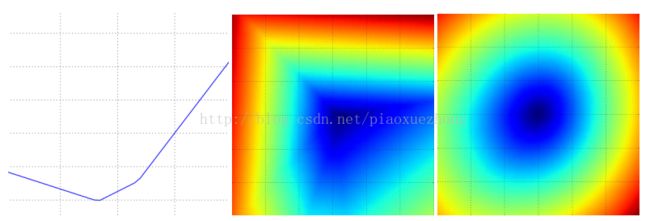斯坦福大学深度学习公开课cs231n学习笔记(3)最优化方法:梯度下降
继续cs231n课程的学习,最优化方法部分:随机梯度下降法。
前面课程介绍了图像分类任务的两个关键部分:
(1)评分函数。将原始图像像素映射为分类评分值。
(2)损失函数。根据分类评分和训练集图像数据实际分类的一致性,来衡量参数集的好坏。损失函数有不同的实现方式(例如:Softmax或SVM)。线性函数的形式是:![]() ,而SVM实现的公式是:
,而SVM实现的公式是:
![]() (1)
(1)
对于图像数据xi,如果基于参数集W做出的分类预测与真实情况相一致,此时的损失值 L 就很低。但也可能出现预测与真实情况不一致的现象,此时需要参数最优化(Optimization),即寻找使得损失函数值最小化的参数集W的过程。
损失函数可视化
这里讨论的损失函数一般是定义在高维空间中的(例如,在CIFAR-10中一个线性分类器的权重矩阵大小是[10x3073],矩阵共有30730个参数)。此时要将参数可视化就很困难。可以在1个维度或者2个维度的方向上对高维空间进行切片。例如,随机生成一个权重矩阵W(该矩阵与高维空间中的一个点对应),然后沿着某个维度方向前进,并记录损失函数值的变化。例如,生成一个随机方向W1,然后沿着该方向,根据不同的a值来计算L(W+aW1)损失值,该过程将生成一个x轴是a值,y轴是损失函数值的图表。同样也可以用在两维度上,通过改变a,b的值计算损失值L(W+aW1+bW2),生成二维图像,其中a,b可以分别表示x轴和y轴,损失函数值用颜色表示。如下图所示:上图中,左:a值与对应损失值的变化图表。中和右:两维度方向上的损失值切片图,蓝色部分表示低损失值,红色部分表示高损失值。注意损失函数的分段线性结构,这可以用数学解释。
从公式可以看出,样本的损失值是以W为参数的max函数的累加和(零阈值是由于 max(0,-)函数)。W的每一行(即wj),有时候它前面是一个正号(当它是错误分类的时候),有时候是一个负号(当它是正确分类的时候)。假设有一个很简单的数据集,它包含3个一维度的点,数据集有3个类别。完整的无正则化SVM损失值计算如下:
由于数据xi和权重wj都是数字。上面式子中包含wj的线性函数,且每一项都会与0比较,取两者的最大值。该过程用图表示为:
根据SVM的损失函数的碗状外形,可以猜测这是一个凸函数。但是将f 函数扩展到神经网络后,目标函数就不是凸函数了,图像会变成凹凸不平的复杂形状。 由于max操作,损失函数中存在一些不可导点(kinks),所以损失函数不可微,因为在这些点处的梯度是没有定义的,但是次梯度(subgradient)是存在且常被使用的。
最优化
损失函数值的大小可以评价参数 W 的好坏。所以最优化的目标是找到使得损失函数取值最小的 W。深度学习调优面对的不仅仅是凸函数,而是最优化一个神经网络,简单地使用凸函数最优化技巧并不能解决问题。
策略1:一个很差的idea:随机搜索
# 假设X_train的每一列对应一个数据样本(例如3073 x 50000)
# 假设Y_train是数据样本的类别标签(大小为50000的一维数组)
# 假设函数L对损失函数进行评价
bestloss = float("inf") # Python assigns the highest possible float value
for num in xrange(1000):
W = np.random.randn(10, 3073) * 0.0001 # generate random parameters
loss = L(X_train, Y_train, W) # get the loss over the entire training set
if loss < bestloss: # keep track of the best solution
bestloss = loss
bestW = W
print 'in attempt %d the loss was %f, best %f' % (num, loss, bestloss)
# 输出:
# in attempt 0 the loss was 9.401632, best 9.401632
# in attempt 1 the loss was 8.959668, best 8.959668
# in attempt 2 the loss was 9.044034, best 8.959668
# in attempt 3 the loss was 9.278948, best 8.959668
# in attempt 4 the loss was 8.857370, best 8.857370
# in attempt 5 the loss was 8.943151, best 8.857370
# in attempt 6 the loss was 8.605604, best 8.605604
# ... (trunctated: continues for 1000 lines)# 假设X_test大小为[3073 x 10000], Y_test为[10000 x 1]
scores = Wbest.dot(Xte_cols) # 10 x 10000, the class scores for all test examples
# 找到每列中分值最大的索引(即预测的分类)
Yte_predict = np.argmax(scores, axis = 0)
# 计算准确率(正确预测的部分)
np.mean(Yte_predict == Yte)
# 返回 0.1555蒙眼徒步者的比喻:想象一个蒙着眼睛的徒步者,正走在一个山地地形上,而他的目标是要慢慢地走到山底。在CIFAR-10的例子中,这座山维度是30730(因为W是3073x10)。徒步者在山上踩的每一个点都对应着一个损失值,该损失值可以看成是该点的海拔。
策略2:局部随机搜索
第一个策略的方法是每走一步都尝试几个随机的方向,如果某个方向是向下的,就向该方向走一步。另一种方法:开始先选择一个随机的权重W,然后生成一个随机的扰动δW ,只有当W+δW对应的损失值变小时,才进行更新。具体代码如下:W = np.random.randn(10, 3073) * 0.001 # generate random starting W
bestloss = float("inf")
for i in xrange(1000):
step_size = 0.0001
Wtry = W + np.random.randn(10, 3073) * step_size
loss = L(Xtr_cols, Ytr, Wtry)
if loss < bestloss:
W = Wtry
bestloss = loss
print 'iter %d loss is %f' % (i, bestloss)策略3:梯度跟随
前两个策略中,在权重空间中搜索能够降低损失函数L值的方向时,是随机的选择。但其实是可以直接计算出最好的方向来的,这个方向就是损失函数的梯度(gradient)。在蒙眼徒步者的比喻中,就是人感受脚下山体的倾斜程度,然后朝着最陡峭的下降方向下山。在一维函数中,斜率表示函数在某一点处的瞬时变化率。而梯度是斜率的一般化表示,它不是一个数值,而是一个向量,梯度是由各个维度的斜率组成的向量(或者称为导数)。一维函数的求导公式如下:
 (4)
(4)
当函数有多个参数时,称为偏导数,此时梯度是由在各个维度上偏导数构成的向量。
梯度计算
利用有限差值来计算梯度
def eval_numerical_gradient(f, x):
"""
一个求函数f在x处的数值梯度的简单实现
- f是只有一个参数的函数
- x是需要计算梯度的点
"""
fx = f(x) # 在原点计算函数值
grad = np.zeros(x.shape)
h = 0.00001
# 对x中所有的索引进行迭代
it = np.nditer(x, flags=['multi_index'], op_flags=['readwrite'])
while not it.finished:
# 计算x+h处的函数值
ix = it.multi_index
old_value = x[ix]
x[ix] = old_value + h # 增加h
fxh = f(x) # 计算f(x + h)
x[ix] = old_value # 存到前一个值中 (非常重要)
# 计算偏导数
grad[ix] = (fxh - fx) / h # 坡度
it.iternext() # 到下个维度
return grad在数学公式中,h的取值趋近于0,然而在实际中,h可以用一个很小的数值(比如例子中的1e-5)代替。理想情况是: h 使用尽可能小的数值。实际中常使用中心差值公式(centered difference formula):
# 要想使用上面的代码,需要一个只有一个参数的函数
# (参数就是权重)包含了X_train和Y_train
def CIFAR10_loss_fun(W):
return L(X_train, Y_train, W)
W = np.random.rand(10, 3073) * 0.001 # 随机权重向量
df = eval_numerical_gradient(CIFAR10_loss_fun, W) # 得到梯度loss_original = CIFAR10_loss_fun(W) # 初始损失值
print 'original loss: %f' % (loss_original, )
# 查看不同步长的效果
for step_size_log in [-10, -9, -8, -7, -6, -5,-4,-3,-2,-1]:
step_size = 10 ** step_size_log
W_new = W - step_size * df # 权重空间中的新位置
loss_new = CIFAR10_loss_fun(W_new)
print 'for step size %f new loss: %f' % (step_size, loss_new)
# 输出:
# original loss: 2.200718
# for step size 1.000000e-10 new loss: 2.200652
# for step size 1.000000e-09 new loss: 2.200057
# for step size 1.000000e-08 new loss: 2.194116
# for step size 1.000000e-07 new loss: 2.135493
# for step size 1.000000e-06 new loss: 1.647802
# for step size 1.000000e-05 new loss: 2.844355
# for step size 1.000000e-04 new loss: 25.558142
# for step size 1.000000e-03 new loss: 254.086573
# for step size 1.000000e-02 new loss: 2539.370888
# for step size 1.000000e-01 new loss: 25392.214036步长的影响:梯度表示出函数变化率最大的方向,但是没有说明在这个方向上应该走多远,此时需要设定步长,步长(也叫学习率)是神经网络训练中最重要(也是最头痛)的超参数之一。以蒙眼徒步者下山为例,我们可以感觉出地形在不同方向上的倾斜程度,但是应该跨出多大的步长是不确定的。如果谨慎地小步走,结果可能比较稳定,但是进展较慢。但是如果想尽快下山,就需要大步走,但结果可能不尽如人意。上面的代码中,在某些点如果步长过大,可能越过最低点,使得损失值更大了。
效率问题:计算数值梯度的复杂性是和参数的数量成线性相关的。在CIFAR-10中有30730个参数,此时损失函数每走一步需要计算30731次损失函数的梯度。而神经网络可能有上千万个参数,显然这个策略并不适合大规模的数据。
用微分分析计算梯度
梯度下降
计算出损失函数的梯度后,程序迭代计算梯度并对参数进行更新,这个过程称为梯度下降,一般普通实现为:# 普通的梯度下降
while True:
weights_grad = evaluate_gradient(loss_fun, data, weights)
weights += - step_size * weights_grad # 进行梯度更新小批量梯度下降(Mini-batch gradient descent):在大规模的应用中(如ILSVRC挑战赛),训练数据可以达到百万级。如果仅仅是为了得到一个参数,计算整个训练集就太浪费了。一个常用的方法是计算训练集中的小批量(batches)数据。例如,在高水平的卷积神经网络中,小批量数据包含256个例子,调优过程如下:
# 普通的小批量数据梯度下降
while True:
data_batch = sample_training_data(data, 256) # 256个数据
weights_grad = evaluate_gradient(loss_fun, data_batch, weights)
weights += - step_size * weights_grad # 参数更新总结
参考:
http://cs231n.github.io/optimization-1/
https://zhuanlan.zhihu.com/p/21360434?refer=intelligentunit
https://zhuanlan.zhihu.com/p/21387326?refer=intelligentunit







